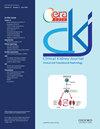Cardiovascular, renal and mortality risk by the KDIGO heatmap in japan
IF 3.9
2区 医学
Q1 UROLOGY & NEPHROLOGY
引用次数: 0
Abstract
Background This study aimed to assess the prognosis of people with chronic kidney disease (CKD) in Japan using the Kidney Disease Improving Global Outcomes (KDIGO) heatmap. Methods The prognoses of individuals with estimated glomerular filtration rates (eGFR) < 90 ml/min/1.73 m2 were evaluated based on the KDIGO heatmap using an electronic medical record database in Japan. The primary outcome was major adverse cardiovascular events (MACE), a composite of myocardial infarction (MI), stroke, heart failure (HF) hospitalization, and in-hospital death (referred to as MACE1). Additionally, ad hoc MACE2 (MI hospitalization, stroke hospitalization, HF hospitalization, and in-hospital death) was examined. The secondary outcome was the renal outcome. Results Of the 543 606 individuals included, the mean age was 61.6 ± 15.3 years, 50.1% were male, and 40.9% lacked urine protein results. The risk of MACEs increased independently with both eGFR decline and increasing proteinuria from the early KDIGO stages: Hazard ratios (with 95% confidence interval) of MACE1 and MACE2, compared to G2A1 were 1.16 (1.12–1.20) and 1.17 (1.11–1.23), respectively, for G3aA1, and 1.17 (1.12–1.21) and 1.35 (1.28–1.43), respectively, for G2A2. This increased up to 2.83 (2.54–3.15) and 3.43 (3.00–3.93), respectively, for G5A3. Risks of renal outcomes also increased with CKD progression. Conclusions This study is the first to demonstrate the applicability of the KDIGO heatmap in assessing cardiovascular and renal risk in Japan. The risk increased from the early stages of CKD, indicating the importance of early diagnosis and intervention through appropriate testing.日本 KDIGO 热图显示的心血管、肾脏和死亡风险
背景 本研究旨在利用肾脏病改善全球预后(KDIGO)热图评估日本慢性肾脏病(CKD)患者的预后。方法 利用日本的电子病历数据库,根据 KDIGO 热图对估计肾小球滤过率(eGFR)为 90 ml/min/1.73 m2 的患者的预后进行评估。主要结果是主要不良心血管事件(MACE),即心肌梗死(MI)、中风、心力衰竭(HF)住院和院内死亡的复合结果(简称 MACE1)。此外,还对 MACE2(心肌梗死住院、中风住院、心力衰竭住院和院内死亡)进行了特别检查。次要结局是肾脏结局。结果 在纳入的 543 606 人中,平均年龄为 61.6 ± 15.3 岁,50.1% 为男性,40.9% 没有尿蛋白结果。从KDIGO早期阶段开始,MACEs风险随着eGFR下降和蛋白尿增加而增加:与 G2A1 相比,G3aA1 的 MACE1 和 MACE2 危险比(含 95% 置信区间)分别为 1.16(1.12-1.20)和 1.17(1.11-1.23),而 G2A2 则分别为 1.17(1.12-1.21)和 1.35(1.28-1.43)。而 G5A3 的风险则分别增至 2.83(2.54-3.15)和 3.43(3.00-3.93)。随着慢性肾功能衰竭的进展,肾功能衰竭的风险也会增加。结论 本研究首次证明了 KDIGO 热图在评估日本心血管和肾脏风险方面的适用性。风险从 CKD 的早期阶段开始增加,这表明了通过适当检测进行早期诊断和干预的重要性。
本文章由计算机程序翻译,如有差异,请以英文原文为准。
求助全文
约1分钟内获得全文
求助全文
来源期刊

Clinical Kidney Journal
Medicine-Transplantation
CiteScore
6.70
自引率
10.90%
发文量
242
审稿时长
8 weeks
期刊介绍:
About the Journal
Clinical Kidney Journal: Clinical and Translational Nephrology (ckj), an official journal of the ERA-EDTA (European Renal Association-European Dialysis and Transplant Association), is a fully open access, online only journal publishing bimonthly. The journal is an essential educational and training resource integrating clinical, translational and educational research into clinical practice. ckj aims to contribute to a translational research culture among nephrologists and kidney pathologists that helps close the gap between basic researchers and practicing clinicians and promote sorely needed innovation in the Nephrology field. All research articles in this journal have undergone peer review.
 求助内容:
求助内容: 应助结果提醒方式:
应助结果提醒方式:


